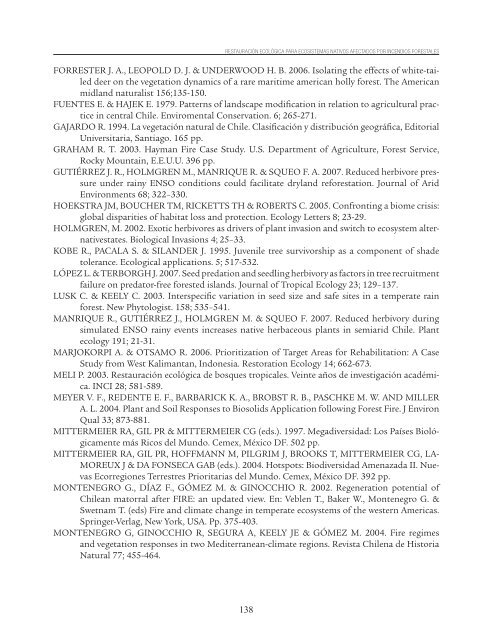Restauracion ecologica ecosistemas nativos
Create successful ePaper yourself
Turn your PDF publications into a flip-book with our unique Google optimized e-Paper software.
RESTAURACIÓN ECOLÓGICA PARA ECOSISTEMAS NATIVOS AFECTADOS POR INCENDIOS FORESTALES<br />
FORRESTER J. A., LEOPOLD D. J. & UNDERWOOD H. B. 2006. Isolating the effects of white-tailed<br />
deer on the vegetation dynamics of a rare maritime american holly forest. The American<br />
midland naturalist 156;135-150.<br />
FUENTES E. & HAJEK E. 1979. Patterns of landscape modification in relation to agricultural practice<br />
in central Chile. Enviromental Conservation. 6; 265-271.<br />
GAJARDO R. 1994. La vegetación natural de Chile. Clasificación y distribución geográfica, Editorial<br />
Universitaria, Santiago. 165 pp.<br />
GRAHAM R. T. 2003. Hayman Fire Case Study. U.S. Department of Agriculture, Forest Service,<br />
Rocky Mountain, E.E.U.U. 396 pp.<br />
GUTIÉRREZ J. R., HOLMGREN M., MANRIQUE R. & SQUEO F. A. 2007. Reduced herbivore pressure<br />
under rainy ENSO conditions could facilitate dryland reforestation. Journal of Arid<br />
Environments 68; 322–330.<br />
HOEKSTRA JM, BOUCHER TM, RICKETTS TH & ROBERTS C. 2005. Confronting a biome crisis:<br />
global disparities of habitat loss and protection. Ecology Letters 8; 23-29.<br />
HOLMGREN, M. 2002. Exotic herbivores as drivers of plant invasion and switch to ecosystem alternativestates.<br />
Biological Invasions 4; 25–33.<br />
KOBE R., PACALA S. & SILANDER J. 1995. Juvenile tree survivorship as a component of shade<br />
tolerance. Ecological applications. 5; 517-532.<br />
LÓPEZ L. & TERBORGH J. 2007. Seed predation and seedling herbivory as factors in tree recruitment<br />
failure on predator-free forested islands. Journal of Tropical Ecology 23; 129–137.<br />
LUSK C. & KEELY C. 2003. Interspecific variation in seed size and safe sites in a temperate rain<br />
forest. New Phytologist. 158; 535–541.<br />
MANRIQUE R., GUTIÉRREZ J., HOLMGREN M. & SQUEO F. 2007. Reduced herbivory during<br />
simulated ENSO rainy events increases native herbaceous plants in semiarid Chile. Plant<br />
ecology 191; 21-31.<br />
MARJOKORPI A. & OTSAMO R. 2006. Prioritization of Target Areas for Rehabilitation: A Case<br />
Study from West Kalimantan, Indonesia. Restoration Ecology 14; 662-673.<br />
MELI P. 2003. Restauración ecológica de bosques tropicales. Veinte años de investigación académica.<br />
INCI 28; 581-589.<br />
MEYER V. F., REDENTE E. F., BARBARICK K. A., BROBST R. B., PASCHKE M. W. AND MILLER<br />
A. L. 2004. Plant and Soil Responses to Biosolids Application following Forest Fire. J Environ<br />
Qual 33; 873-881.<br />
MITTERMEIER RA, GIL PR & MITTERMEIER CG (eds.). 1997. Megadiversidad: Los Países Biológicamente<br />
más Ricos del Mundo. Cemex, México DF. 502 pp.<br />
MITTERMEIER RA, GIL PR, HOFFMANN M, PILGRIM J, BROOKS T, MITTERMEIER CG, LA-<br />
MOREUX J & DA FONSECA GAB (eds.). 2004. Hotspots: Biodiversidad Amenazada II. Nuevas<br />
Ecorregiones Terrestres Prioritarias del Mundo. Cemex, México DF. 392 pp.<br />
MONTENEGRO G., DÍAZ F., GÓMEZ M. & GINOCCHIO R. 2002. Regeneration potential of<br />
Chilean matorral after FIRE: an updated view. En: Veblen T., Baker W., Montenegro G. &<br />
Swetnam T. (eds) Fire and climate change in temperate ecosystems of the western Americas.<br />
Springer-Verlag, New York, USA. Pp. 375-403.<br />
MONTENEGRO G, GINOCCHIO R, SEGURA A, KEELY JE & GÓMEZ M. 2004. Fire regimes<br />
and vegetation responses in two Mediterranean-climate regions. Revista Chilena de Historia<br />
Natural 77; 455-464.<br />
138



